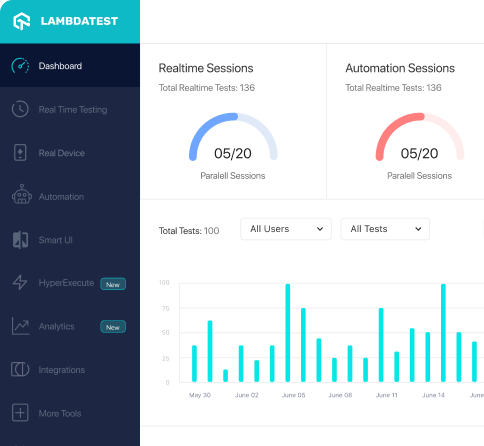How to use PowerMockObjectFactory class of org.powermock.modules.testng package
Best Powermock code snippet using org.powermock.modules.testng.PowerMockObjectFactory
Source:PowerMockTestNGMockStaticCases.java
1package com.bascker.library.powermock;2import org.apache.commons.lang3.StringUtils;3import org.powermock.core.classloader.annotations.PrepareForTest;4import org.powermock.modules.testng.PowerMockObjectFactory;5import org.slf4j.Logger;6import org.slf4j.LoggerFactory;7import org.testng.Assert;8import org.testng.IObjectFactory;9import org.testng.annotations.BeforeClass;10import org.testng.annotations.ObjectFactory;11import org.testng.annotations.Test;12import static org.mockito.Matchers.anyString;13import static org.powermock.api.mockito.PowerMockito.mockStatic;14import static org.powermock.api.mockito.PowerMockito.when;15/**16 * PowerMockito & TestNG æ¥ Mock static æ¹æ³17 *18 * 1.PowerMockito & TestNG Mock static æ¹æ³çæ¥éª¤19 * 1) @PrepareForTest: æå®è¦ Mock çéæç±»20 * 2) mockStatic(): æå®è¦ Mock çéæç±»21 * 3) @ObjectFactory: éç¹22 * 4) mock 对象æ¹æ³è°ç¨23 *24 * 2.@PrepareForTest25 * 2.1 ä½¿ç¨ PowerMockito 强大åè½(å¦ Mock static/final/private çæ¹æ³)æ¶ï¼å¿
须使ç¨26 * 2.2 PowerMock ä¼æ ¹æ®å¼åè
ç mock è¦æ±ï¼ä¿®æ¹ @PrepareForTest ä¸æå®ç class æ件, 以满足éæ±.27 * è¥ mock çæ¯ç³»ç»ç±»ç final/static æ¹æ³ï¼åä¸ä¼ç´æ¥ä¿®æ¹ç³»ç»ç±»ç class æ件ï¼èæ¯ä¿®æ¹è°ç¨ç³»ç»ç±»ç class sæ件28 * 2.3 被 @PrepareForTest æ 注å, è¿è¡æµè¯ç¨ä¾æ¶, ä¼å建ä¸ä¸ªæ°ç {@link org.powermock.core.classloader.MockClassLoader} å®ä¾,29 * ç¶åå 载该æµè¯ç¨ä¾ä½¿ç¨å°çç±»(ç³»ç»ç±»é¤å¤)30 *31 * 3.IObjectFactory32 * 3.1 ç¨äºå®ä¾å被æµè¯å¯¹è±¡33 * 3.2 ä½¿ç¨ @ObjectFactory æ 注ä¸ä¸ªè¿å IObjectFactory çæ¹æ³ï¼è¡¨ç¤ºä½¿ç¨è¯¥å¯¹è±¡å·¥åæ¥äº§ç TestNG 对象34 *35 * @author bascker36 */37@Test38@PrepareForTest(StringUtils.class)39public class PowerMockTestNGMockStaticCases {40 private static final Logger LOGGER = LoggerFactory.getLogger(PowerMockTestNGMockStaticCases.class);41 @BeforeClass42 public void beforeClass() {43 mockStatic(StringUtils.class);44 }45 @ObjectFactory46 public IObjectFactory setObjectFactory() {47 return new PowerMockObjectFactory();48 }49 public void testIsEmpty() {50 // mock isEmpty() è°ç¨51 when(StringUtils.isEmpty(anyString())).thenReturn(true);52 final String str = "PowerMockito & TestNG";53 Assert.assertTrue(StringUtils.isEmpty(str));54 }55}...Source:MockStaticCase.java
...3import com.bascker.library.powermock.model.UserFactory;4import org.mockito.Mock;5import org.mockito.MockitoAnnotations;6import org.powermock.core.classloader.annotations.PrepareForTest;7import org.powermock.modules.testng.PowerMockObjectFactory;8import org.testng.Assert;9import org.testng.IObjectFactory;10import org.testng.annotations.BeforeMethod;11import org.testng.annotations.ObjectFactory;12import org.testng.annotations.Test;13import static org.mockito.Matchers.anyString;14import static org.mockito.Mockito.mockingDetails;15import static org.powermock.api.mockito.PowerMockito.mockStatic;16import static org.powermock.api.mockito.PowerMockito.when;17/**18 * æµè¯åºæ¯: ä¸ç´æ¥ Mock çå® User çè°ç¨, èæ¯éè¿ mock å
¶å
é¨å®ç°æ¹æ³çè°ç¨æ¥äº§ç mock æ°æ®19 *20 * @author bascker21 */22@Test23@PrepareForTest(UserFactory.class)24public class MockStaticCase {25 @BeforeMethod26 protected void before() {27 MockitoAnnotations.initMocks(this);28 }29 @ObjectFactory30 public IObjectFactory getObjectFactory() {31 return new PowerMockObjectFactory();32 }33 @Mock34 private UserFactory userFactory;35 public void test() {36 final User user = new User();37 Assert.assertEquals(user.getUser("paul").getName(), "paul");38 mockStatic(UserFactory.class);39 when(UserFactory.getInstance()).thenReturn(userFactory);40 when(userFactory.getUser(anyString())).thenReturn(new User("bascker"));41 Assert.assertTrue(mockingDetails(UserFactory.getInstance()).isMock());42 Assert.assertEquals(user.getUser("paul").getName(), "bascker");43 }44}...Source:ServiceTest.java
1package jreader.services.impl;2import org.powermock.api.mockito.PowerMockito;3import org.powermock.core.classloader.annotations.PrepareForTest;4import org.powermock.modules.testng.PowerMockObjectFactory;5import org.powermock.modules.testng.PowerMockTestCase;6import org.testng.IObjectFactory;7import org.testng.annotations.BeforeMethod;8import org.testng.annotations.ObjectFactory;9import com.googlecode.objectify.Ref;10@PrepareForTest(Ref.class)11public class ServiceTest extends PowerMockTestCase {12 @ObjectFactory13 public IObjectFactory getObjectFactory() {14 return new PowerMockObjectFactory();15 }16 @BeforeMethod()17 public void setupMockingForRef() {18 PowerMockito.mockStatic(Ref.class);19 }20}...PowerMockObjectFactory
Using AI Code Generation
1package com.powermock;2import org.powermock.modules.testng.PowerMockObjectFactory;3import org.testng.annotations.BeforeTest;4import org.testng.annotations.ObjectFactory;5import org.testng.annotations.Test;6public class PowerMockObjectFactoryTest {7 public PowerMockObjectFactory getObjectFactory() {8 return new PowerMockObjectFactory();9 }10 public void setUp() {PowerMockObjectFactory
Using AI Code Generation
1package com.powermock;2import org.powermock.modules.testng.PowerMockObjectFactory;3import org.testng.annotations.ObjectFactory;4public class PowerMockTestNGExample {5 public PowerMockObjectFactory getObjectFactory() {6 return new PowerMockObjectFactory();7 }8}9package com.powermock;10import org.powermock.modules.testng.PowerMockObjectFactory;11import org.testng.annotations.ObjectFactory;12public class PowerMockTestNGExample {13 public PowerMockObjectFactory getObjectFactory() {14 return new PowerMockObjectFactory();15 }16}17package com.powermock;18import org.powermock.modules.testng.PowerMockObjectFactory;19import org.testng.annotations.ObjectFactory;20public class PowerMockTestNGExample {21 public PowerMockObjectFactory getObjectFactory() {22 return new PowerMockObjectFactory();23 }24}25package com.powermock;26import org.powermock.modules.testng.PowerMockObjectFactory;27import org.testng.annotations.ObjectFactory;28public class PowerMockTestNGExample {29 public PowerMockObjectFactory getObjectFactory() {30 return new PowerMockObjectFactory();31 }32}33package com.powermock;34import org.powermock.modules.testng.PowerMockObjectFactory;35import org.testng.annotations.ObjectFactory;36public class PowerMockTestNGExample {37 public PowerMockObjectFactory getObjectFactory() {38 return new PowerMockObjectFactory();39 }40}41package com.powermock;42import org.powermock.modules.testng.PowerMockObjectFactory;43import org.testng.annotations.ObjectFactory;44public class PowerMockTestNGExample {45 public PowerMockObjectFactory getObjectFactory() {46 return new PowerMockObjectFactory();47 }48}49package com.powermock;50import org.powermock.modules.testng.PowerPowerMockObjectFactory
Using AI Code Generation
1@PowerMockIgnore({"javax.management.*"})2@PrepareForTest({PowerMockObjectFactory.class})3@PowerMockObjectFactory(PowerMockObjectFactory.class)4public class PowerMockObjectFactoryTest extends TestCase {5 public void testPowerMockObjectFactory() {6 PowerMockObjectFactory mockPowerMockObjectFactory = PowerMock.createMock(PowerMockObjectFactory.class);7 PowerMock.expectNew(PowerMockObjectFactory.class).andReturn(mockPowerMockObjectFactory);8 PowerMock.replay(mockPowerMockObjectFactory);9 PowerMock.verify(mockPowerMockObjectFactory);10 }11}12import org.powermock.api.easymock.PowerMock;13import org.powermock.core.classloader.annotations.PrepareForTest;14import org.powermock.modules.testng.PowerMockObjectFactory;15import org.powermock.modules.testng.PowerMockTestCase;16import org.testng.annotations.Test;17public class PowerMockObjectFactoryTest extends PowerMockTestCase {18 public void testPowerMockObjectFactory() {19 PowerMockObjectFactory mockPowerMockObjectFactory = PowerMock.createMock(PowerMockObjectFactory.class);20 PowerMock.expectNew(PowerMockObjectFactory.class).andReturn(mockPowerMockObjectFactory);21 PowerMock.replay(mockPowerMockObjectFactory);22 PowerMock.verify(mockPowerMockObjectFactory);23 }24}PowerMockObjectFactory
Using AI Code Generation
1package testng;2import org.powermock.modules.testng.PowerMockObjectFactory;3import org.testng.Assert;4import org.testng.annotations.BeforeClass;5import org.testng.annotations.ObjectFactory;6import org.testng.annotations.Test;7import static org.powermock.api.mockito.PowerMockito.*;8public class TestNGPowerMockObjectFactoryTest {9 public PowerMockObjectFactory getObjectFactory() {10 return new PowerMockObjectFactory();11 }12 public void setUp() {13 mockStatic(Math.class);14 }15 public void test() {16 when(Math.abs(-1)).thenReturn(1);17 Assert.assertEquals(Math.abs(-1), 1);18 }19}20package testng;21import org.powermock.modules.testng.PowerMockObjectFactory;22import org.testng.Assert;23import org.testng.annotations.BeforeClass;24import org.testng.annotations.ObjectFactory;25import org.testng.annotations.Test;26import static org.powermock.api.mockito.PowerMockito.*;27public class TestNGPowerMockObjectFactoryTest {28 public PowerMockObjectFactory getObjectFactory() {29 return new PowerMockObjectFactory();30 }31 public void setUp() {32 mockStatic(Math.class);33 }34 public void test() {35 when(Math.abs(-1)).thenReturn(1);36 Assert.assertEquals(Math.abs(-1), 1);37 }38}Automation Testing Tutorials
Learn to execute automation testing from scratch with LambdaTest Learning Hub. Right from setting up the prerequisites to run your first automation test, to following best practices and diving deeper into advanced test scenarios. LambdaTest Learning Hubs compile a list of step-by-step guides to help you be proficient with different test automation frameworks i.e. Selenium, Cypress, TestNG etc.
LambdaTest Learning Hubs:
- JUnit Tutorial
- TestNG Tutorial
- Webdriver Tutorial
- WebDriverIO Tutorial
- Protractor Tutorial
- Selenium 4 Tutorial
- Jenkins Tutorial
- NUnit Tutorial
- Jest Tutorial
- Playwright Tutorial
- Cypress Tutorial
- PyTest Tutorial
YouTube
You could also refer to video tutorials over LambdaTest YouTube channel to get step by step demonstration from industry experts.
Most used methods in PowerMockObjectFactory
Try LambdaTest Now !!
Get 100 minutes of automation test minutes FREE!!



